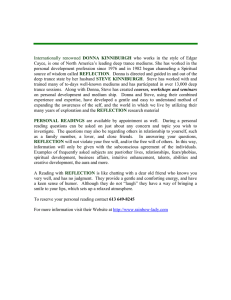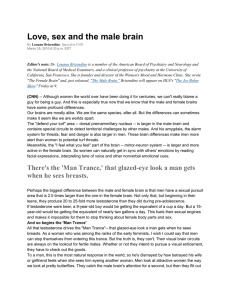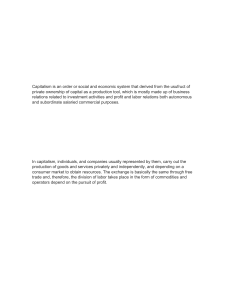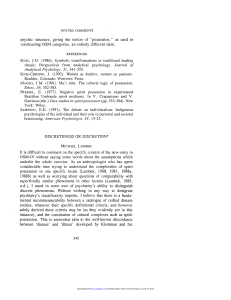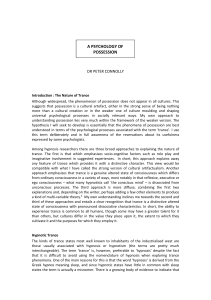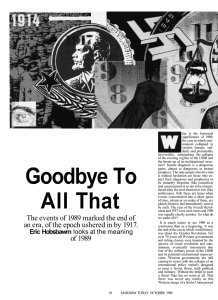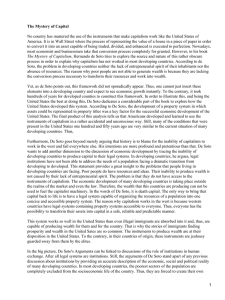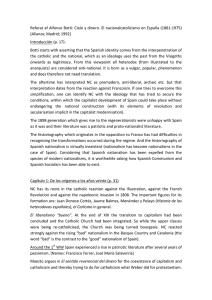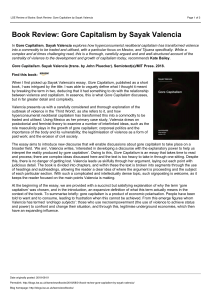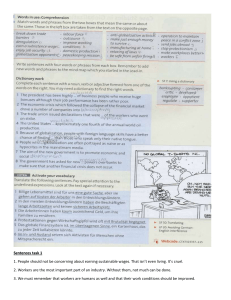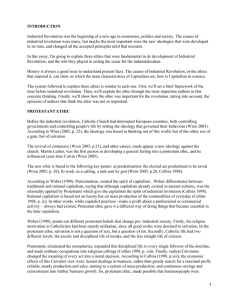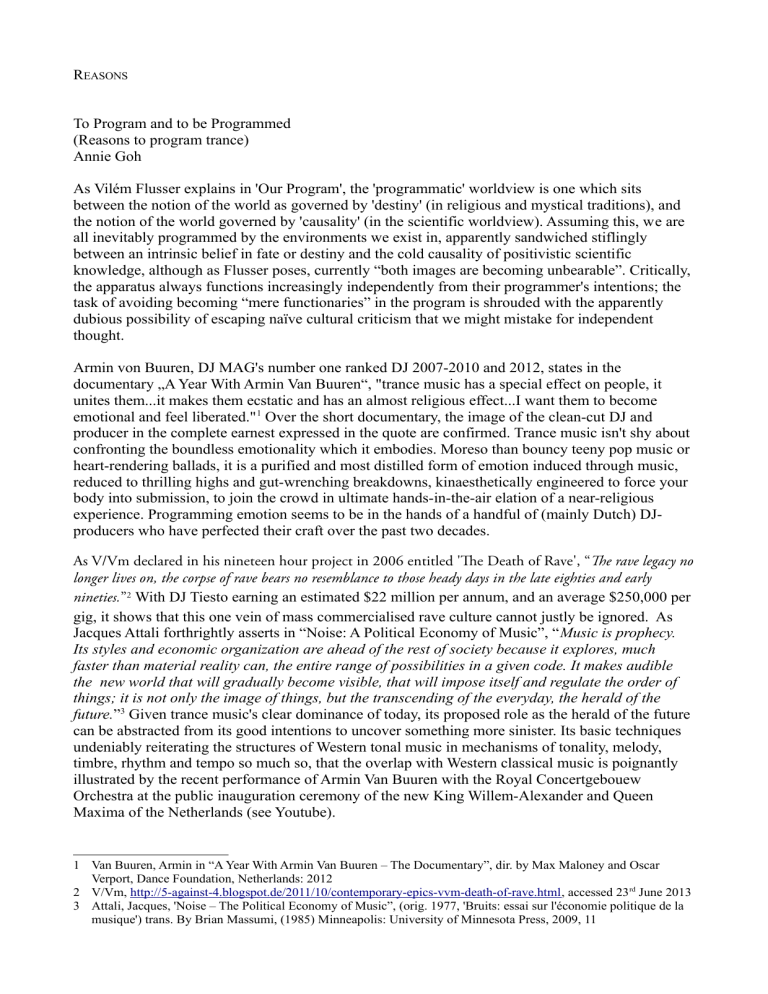
REASONS To Program and to be Programmed (Reasons to program trance) Annie Goh As Vilém Flusser explains in 'Our Program', the 'programmatic' worldview is one which sits between the notion of the world as governed by 'destiny' (in religious and mystical traditions), and the notion of the world governed by 'causality' (in the scientific worldview). Assuming this, we are all inevitably programmed by the environments we exist in, apparently sandwiched stiflingly between an intrinsic belief in fate or destiny and the cold causality of positivistic scientific knowledge, although as Flusser poses, currently “both images are becoming unbearable”. Critically, the apparatus always functions increasingly independently from their programmer's intentions; the task of avoiding becoming “mere functionaries” in the program is shrouded with the apparently dubious possibility of escaping naïve cultural criticism that we might mistake for independent thought. Armin von Buuren, DJ MAG's number one ranked DJ 2007-2010 and 2012, states in the documentary „A Year With Armin Van Buuren“, "trance music has a special effect on people, it unites them...it makes them ecstatic and has an almost religious effect...I want them to become emotional and feel liberated." 1 Over the short documentary, the image of the clean-cut DJ and producer in the complete earnest expressed in the quote are confirmed. Trance music isn't shy about confronting the boundless emotionality which it embodies. Moreso than bouncy teeny pop music or heart-rendering ballads, it is a purified and most distilled form of emotion induced through music, reduced to thrilling highs and gut-wrenching breakdowns, kinaesthetically engineered to force your body into submission, to join the crowd in ultimate hands-in-the-air elation of a near-religious experience. Programming emotion seems to be in the hands of a handful of (mainly Dutch) DJproducers who have perfected their craft over the past two decades. As V/Vm declared in his nineteen hour project in 2006 entitled 'The Death of Rave', “The rave legacy no longer lives on, the corpse of rave bears no resemblance to those heady days in the late eighties and early nineties.”2 With DJ Tiesto earning an estimated $22 million per annum, and an average $250,000 per gig, it shows that this one vein of mass commercialised rave culture cannot justly be ignored. As Jacques Attali forthrightly asserts in “Noise: A Political Economy of Music”, “Music is prophecy. Its styles and economic organization are ahead of the rest of society because it explores, much faster than material reality can, the entire range of possibilities in a given code. It makes audible the new world that will gradually become visible, that will impose itself and regulate the order of things; it is not only the image of things, but the transcending of the everyday, the herald of the future.”3 Given trance music's clear dominance of today, its proposed role as the herald of the future can be abstracted from its good intentions to uncover something more sinister. Its basic techniques undeniably reiterating the structures of Western tonal music in mechanisms of tonality, melody, timbre, rhythm and tempo so much so, that the overlap with Western classical music is poignantly illustrated by the recent performance of Armin Van Buuren with the Royal Concertgebouew Orchestra at the public inauguration ceremony of the new King Willem-Alexander and Queen Maxima of the Netherlands (see Youtube). 1 Van Buuren, Armin in “A Year With Armin Van Buuren – The Documentary”, dir. by Max Maloney and Oscar Verport, Dance Foundation, Netherlands: 2012 2 V/Vm, http://5-against-4.blogspot.de/2011/10/contemporary-epics-vvm-death-of-rave.html, accessed 23rd June 2013 3 Attali, Jacques, 'Noise – The Political Economy of Music”, (orig. 1977, 'Bruits: essai sur l'économie politique de la musique') trans. By Brian Massumi, (1985) Minneapolis: University of Minnesota Press, 2009, 11 This image of actual royalty and trance royalty cavorting on stage becomes particularly significant when we consider what the idea of “music as prophecy” has the potentiality to be, and the deeply problematic situation that this striking example exposes. A Nietzschean eternal return of the same accelerated into a worse case scenario, in which the sensory ecology of late-capitalism must be brought under the microscope for examination. In her article on the “Ordinary Psychopathologies of Cognitive Capitalism” 4 Tiziana Terranova, draws on the oft-cited rational and irrational nature of all societies as set out by Deleuze and Guattari in 'Capitalism and Schizophrenia'. Terranova outlines two ordinary 'illnesses' which are often associated in relation to our increased interaction with information and communication technologies: attention deficit disorder and anhedonia (the inability to feel pleasure). This thereby questions the normative distinctions between “normal and pathological” and normalizes the disorders of ADD and anhedonia as mass phenomena of which many of us are likely to suffer from. Her citation of Jonathan Crary's work on early capitalism and the new commercial culture of urban sensory stimulation is of particular relevance here. He shows early capitalism as bringing about the 'crisis of inattentiveness' and with its structures, 'new methods for managing and regulating perception'. The in-built euphoric quality which lies at the core of trance music, the build ups, breakdowns, energizing beats and beatless releases can be construed as a direct consequence of this crisis of inattentiveness. Simultaneously euphoric and disphoric, providing both melancholy and a kind of cathartic overcoming thereof within the music, it is the dramaturgy we are familiar with from Hollywood blockbusters, played out in the space of a few minutes and in live situations harnessed within the social ritual of collective gathering and dancing. Troubling in this observation of these large-scale events, it resonates as a striking example of what aesthetic theorist Mario Perniola calls 'gia sentito';5 aside from the supposed singularity and individuality possible in aesthetic experience, 'gia sentito' is the 'already felt' of ready-made sensibility, pre-packaged for the masses. The sonic affect of trance music is one of exactly this type of pure and lavish emotional sensation. The mass, when compared for example to the early UK rave scene, once connoted with the blissful collectivity as a reaction to the individualistic, neoliberal economic policies of Thatcherism, comes into bloom as the sheer impossibility of an individualised subjective experience, a situation in which aural pleasure becomes commodified and even enforced. Max Weber's work 'The Rational and Social Foundations of Music' from 1911 addresses the establishment and standardisation of the Western tonal system in his survey and critique of the rationalization of social and economic life. The well-tempered scale, the scale split into twelve semitones in an octave as well as its practical implications for example in the standardisation of keyboard instruments is concluded with a subtle yet tangible sour taste, "There is no doubt that the distance principle which is akin to harmony and which is the basis of the subdivision of the intervals of our keyboard instruments, has an extensively dulling effect upon the delicacy of listening." A century on from this damning prognostication, trance music proves Weber's point. What could be more dulling on the senses than hours of trance music's smothering emotionality? Far from the destruction of tonality, or as Luigi Russolo in a very different context just two years later called for in 'The Art of Noises', to 'break … from this restrictive circle of pure sounds and conquer the infinite variety of noise-sounds', trance music emphatically nurtures the rhythmic and tonal conservative traditions of Western music. Considering “rational” and “irrational” nature of society in trance music, we can see both of Terranova's proposed maladies – attention deficit disorder and anhedonia – being overcompensated 4 Terranova, Tiziana “Ordinary psychopathologies of cognitive capitalism” in The Psychopathologies of Cognitive Capitalism, Edited by Arne De Boever & Warren Neidich, Archive Books, Berlin: 2013 5 See for example Mario Perniola's “New Age and the culture of performance” http://www.marioperniola.it/site/dettagliotext.asp?idtexts=133, accessed 23rd June 2013 through trance. Yet why would this be considered dangerous? They're just having a good time aren't they? A common theme in the work of Vilém Flusser, is his damning critique of Western culture and adamant rejection of many of its often unquestioned basic values. Where Max Weber's theories on increasing rationalization of social and material life via the apparatus of bureaucratic and legal administration and industrial capitalism are often seen as idealizing these, he was in fact also keen to highlight the restriction on human freedom of these. Granted the unavoidable historical hindsight of the post-Holocaust era, it bears a striking resemblance to Hannah Arendt's 1963 coining of the term 'the banality of evil' in reference to the trial of Adolf Eichmann. 6 At the core of her then very controversial statement, was the proposal that at the core of the evils of the Holocaust were not the actions of evil individuals, but the normal, ideologically entrained civil servants following orders of the state and political system. Flusser, drawing much on Arendt's thought, warns us against becoming mere functionaries of the apparatus by attacking the very basis of Western “rationality”. In his essay, 'The Ground We Tread' he writes, 'Auschwitz is not a violation of Western models of behaviour, it is, on the contrary, the result of the application of such models'7. This resonating heavily, he importantly also states, “it is not possible to reject one's own culture. It is the ground we tread. Those who seek to reject their own culture (as Nietzsche did with Judeo-Christianity), fall victim to madness.”8 We cannot help but be programmed by the apparatus, is what Flusser can readily admit, but as he says “we must continue progressing, despite everything.” Such absurdity can only begin to be counteracted with the acknowledgment of it. Within this, 'chance becomes necessity' in the programmatic perspective as Flusser says, “it surpasses the linear structure of “purpose-aim” and “cause-effect” given in both religious-mystical and scientific models. The programmatic view point has multiple dimensions.” 9 Reasons to program trance therefore acknowledge the absurdity of chance; cultural programming and the programming of emotion cumulate in the conclusion of algorithmic programmed trance music. In the work “The Banality of Affect”, it is to almost say, “I was always destined to program trance”, then to almost say, “this and this factor caused me to program trance”, but then finally to program trance music and play the game of absurdity. http://www.banalityofaffect.net how to program euphoria how to make your assets grow overnight and see new rates in euphoric programming rocket sky high Do you want to make people feel ecstatic New on the market, a ground breaking new technology to make earnings increase on average 25 fold per annum We have often visited your website and hope we can give you an opportunity to show you our products. The Banality of Affect2000TM will help you guaranteed to cut through the competition and realise the full potential of your algorithmic trance generator We take Dutch stock exchange and convert it into a resourceful fluctuating euphoria potential This means the more growth in the Dutch market, you will benefit from assets It Needs Your Full 6 Arendt, Hannah “Eichmann in Jerusalem – A Report on the Banality of Evil”, New York: Viking Press, 1963 7 Flusser, Vilém, Post-History, (1983) Trans. Rodrigo Maltez-Novaes, 1 st Edition, Minneapolis: Univocal Press, 2013, 7 8 Ibid., 7, 9 Flusser, V., Post History , 24 Attention Today!!! Strong growth means your trance will not have to work so hard, tempo will drop and your dancers will move more effectively. Just in case of Bad News on stock market contrarily increases the worker using special kinaesthetic technology, faster dancing will Identify big break out on stock moving up!! Second level euphoric Why work for anybody else? Guaranteed 100% success first time. We take bad news and use the best conversion rates to transfer it into pure euphoria. All catastrophes can be averted with up-to-the-second lightning fast communication transfer, this is the most reliable software on the market. Cybernetic technologies for cybercitizens of the twenty-first century. Best possible status uses harmonising stasis counterbalances also good news, to avoid euphoria overload new patented technology enables small amounts of dysphoria melancholy to enact upon your mood. Genuine complete affect control on the euphoria dysphoria axis for you and your customers. New extra added feature fresh from our research and development team in California. Ever thought TOO BORING, well B0R3DOM will be redirected to the ultimate trance music generator. The axis of weird and boredom ensures that news will be automatically ordered according to redundancy and Shannon's information theory. Dr. Annie goh says: "I saw it work like magic." (Annie goh is TRUSTED source in the field.) UST $129... to good to be troo? I thouhgt s0 too ....at first. Try it now.
